Fire and Rescue Services Statistics, Scotland 2011-12
Fire and Rescue Services Statistics, Scotland 2011-12
4. Commentary
Fire Stations
Fire stations in Scotland have been classified in the following manner: Wholetime, Retained Duty System (RDS), Volunteer and Day. The classification relates to the staff who crew these stations. For example, a station is considered wholetime if the majority of staff at the station are employed as wholetime within a 24 hour period.
4.1. Number of Fire Stations (Table 1 and 1a)
As of the 31st March 2012 there were 371 fire stations in Scotland. Of these, 73 were primarily wholetime, 241 RDS , 53 Volunteer and 4 Day.
Highlands and Islands have the highest number of stations with 115, followed by Strathclyde with 110. These FRSs cover the biggest two geographical areas in Scotland.
The majority of stations in Scotland are RDS (65 %), then Wholetime (20 %), Volunteer (14 %) and finally Day (1%) (Chart 1).
Of the 73 Wholetime stations, the majority are in Strathclyde (52 %) followed by Lothian and Borders (18 %).
Chart 1 - Scotland's Fire and Rescue Services Stations by staffing type 2011-12
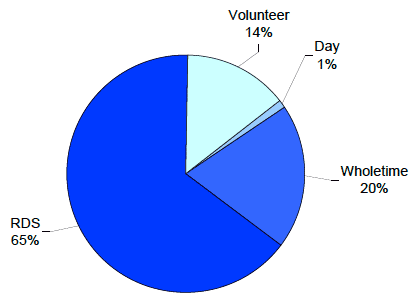
4.2. Type of Equipment (Table 2)
Scotland has 565 operational vehicles as of the 31 March 2012. There are 446 pumping appliances, constituting 79 % of all operational vehicles. Strathclyde (160), followed by Highlands and Islands (138) have the largest numbers of operational vehicles, which is to be expected as together they have 61 % of the stations in Scotland.
Scotland has 983 non-operational vehicles, of which 80 are reserve or training appliances (8 %).
Workforce
4.3. Number of Staff (Table 3, 3a and 4)
Table 3 shows the headcount of staff, at FRS level, as of the 31 March 2010, 2011 and 2012. The headcount figures do not take into consideration individuals' working hours, but for the first time this year information on full time equivalents has also been supplied (Table 4).
As explained in section 3.1, the figures for RDS for 2009-10 and 2010-11, have been realigned with the new collection methodology.
The total headcount of FRS staff (including volunteers) decreased by 16 in 2010-11 from 9,056 to 9,040 in 2011-12. Wholetime operational staff accounted for the largest decrease, reducing by 47 (Chart 2). The number of support staff and volunteers have both increased by 22 from last year figures.
Chart 2 - Scotland's Fire and Rescue Services Headcount by type of staffing - 2009-10, 2010-11 and 2011-12
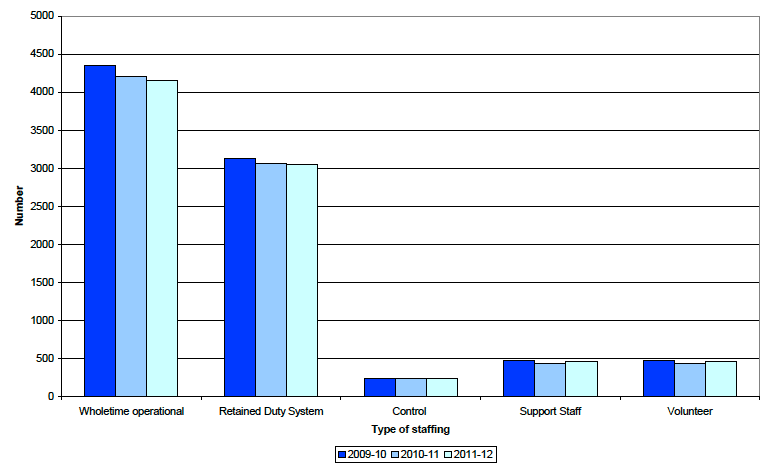
For the first time the full time equivalent (FTE) information was collected on FRS staff (apart from volunteers). The FTE is based on the contract on which the person is employed. For example, if the member of staff is employed part time on a RDS contract, the FTE will be based on the FRS standard RDS contract, not for example the wholetime operational contract.
When volunteers are excluded from the total FRS staff figures, the comparison for 2011-12 is 8,156.8 FTE against 8,581 headcount. Table A shows that in the FRS, part-time employment is most prevalent within RDS and support staffing.
Table A - Scotland's Fire and Rescue Services staffing by Headcount and Full-time equivalent (FTE)
| Staffing Type | Headcount | FTE |
|---|---|---|
| Wholetime operational | 4,159 | 4,159.0 |
| Retained Duty System (RDS) | 3,052 | 2,812.5 |
| Control | 234 | 224.7 |
| Support staff | 1,136 | 960.6 |
| All staff (excluding volunteers) Total | 8,581 | 8,156.8 |
4.4 Gender (Table 5, 5a, 5b and 6)
In 2011-12 the gender split of headcount figures in Scotland's FRSs was 86.3 % male and 13.7 % female.
Of the 1,240 female staff, the majority (52 %) were working in the support staff category. Whereas of the 7,800 male staff, the majority, 51 %, were working as wholetime operational staff (Chart 3).
Chart 3 - Percentage of staffing type by gender as at 31 March 2012 - Scotland
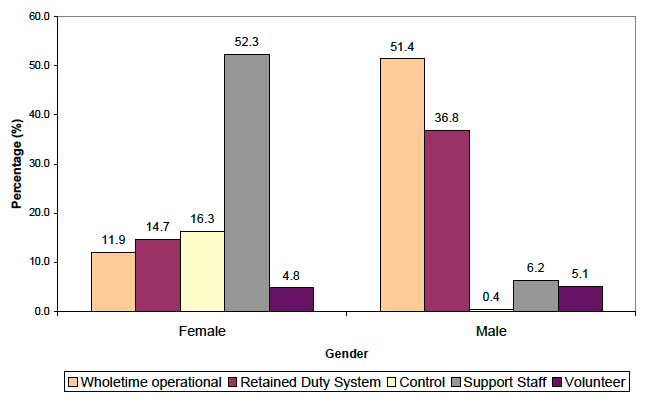
Notes: percentages calculated on headcount
Chart 4 shows the gender split within the different staffing types in the FRS as at 31 March 2012. The proportion of females was highest in control rooms at 86 % (202 out of 234) whereas the proportion of males was highest in wholetime operational staffing at 96% (4,011 out of 4,159).
Chart 4 - Percentage by gender within each type of staffing as at 31 March 2012 - Scotland
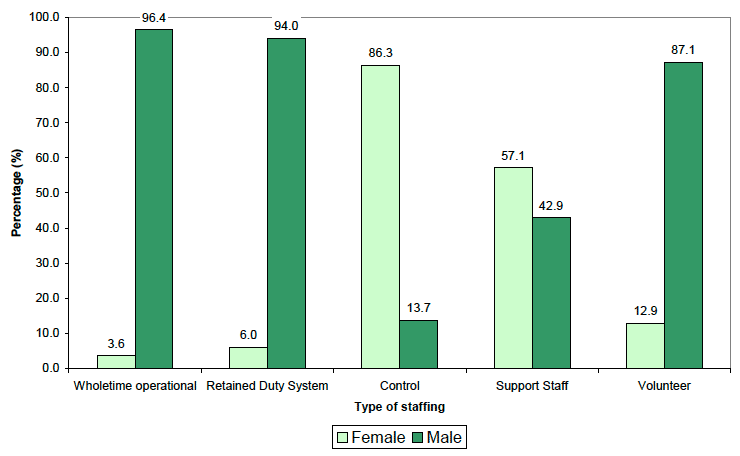
Notes: percentages calculated on headcount
The age bands chosen for the figures have been selected to reflect the different retirement possibilities for FRS personnel; this is why unequal age range intervals have been used (Table 7 and 7a). A more comprehensive definition of retirement ages can be found in paragraph 6.3.9. The main distinction is that wholetime operational and RDS staff, involved in a fire fighting capacity, can retire before the age of 60, depending on their role and number of years service. Control staff and other support staff follow the national guidelines for retirement age in recent UK government pension acts.
The overall figures for Scotland show that 43 % (3,863) of all FRS staff were in the 40-49 age range, with 28 % (2,548) within the 30-39 age range, followed by 18 % (1,616) in the 50 and over age range and finally 11 % (1,013) were under 30 years old.
For each of the staffing types the highest proportion of personnel was within the 40-49 age range, apart from 'support staff' where 39 % of staff were 50 years old and over (Chart 5). As expected, wholetime operational staff had the lowest percentage of staff in the 50 and over age range (10 %), due to retirement arrangements for operational staff.
Chart 5 - Percentage of age range within each type of Fire and Rescue Service staffing as at 31 March 2012
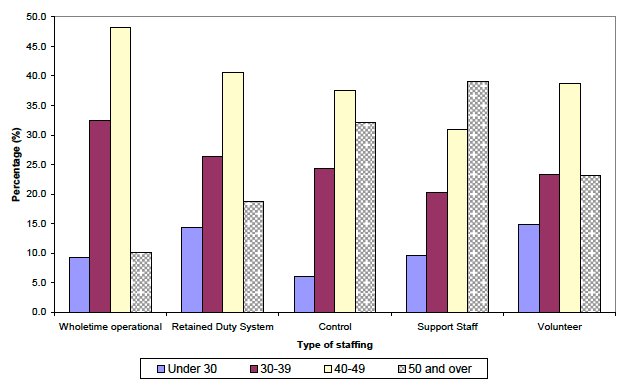
Notes: percentages calculated on headcount
4.6 Ethnicity and Disability (Table 8 and 9)
As of 31 March 2012, 0.6 % of Scotland's FRS staff were recorded as belonging to an ethnic minority group. Within the five staffing categories the highest proportion of ethnic minority staff was in support staff at 1.0 % and the lowest, at 0.2 %, in RDS staff and volunteers.
There were 25.0 % of staff who recorded their ethnic category as "Not Stated" in this year's return.
As of 31 March 2012, 0.6 % of Scotland's FRS staff were recorded as disabled. Within the five staffing categories the highest proportion of disabled staff was support staff (1.4 %) and the lowest was RDS staff (0.3 %).
Attacks on Fire and Rescue Personnel
4.7 Attacks and personnel injured (Table 10, 10a, 10b, 11, 11a and 11b)
The Incident Recording System (IRS) collects information on incidents that Scotland's FRSs attend. The number of incidents where attacks on FRSs personnel occurred is recorded. For example, if items were thrown at 3 fire appliances in one incident, this attack would be recorded as one incident, not 3 attacks. However, the number of personnel injured is recorded individually, so if 2 injuries occurred at 1 incident this would be recorded as 2 and not 1.
In 2010-11 there were 172 incidents where attacks occurred and 14 personnel were injured. In provisional figures for 2011-12 there were 112 incidents recorded where attacks occurred. However, the number of personnel injured in attacks at incidents decreased by 13 to a total of 1.
The most common type of attack at incidents during 2011-12 was 'Objects thrown at fire fighters and/or appliances', followed by 'Verbal abuse'.
In 2010-11, Scotland's FRSs attended 100,280 incidents, attacks occurred at 0.17 % of these. At the time of this publication, incidents for 2011-12 were not available so we are unable to report on this year's percentage.
Home Fire Safety Visits (HFSV)
Fire prevention is an important part of Scotland's FRS work, it is a main element of integrated risk management planning (IRMP). The Fire (Scotland) Act 2005 places a statutory duty on each FRS to promote fire safety. This involves carrying out work to prevent fires in the community. Initiatives include Home Fire Safety Visits (HFSV), youth engagement, working with other agencies to identify those at risk of fire in the home, community road shows, media campaigns etc.
Each FRS has a community fire safety policy tailored to local needs, for example, if there has been a spate of deliberate fire-raising in an area, the local priority may be youth engagement activity, whereas another area may have identified working with other agencies to perform HFSV as their priority.
For a HFSV, FRS personnel visit members of the public in their own homes, help people assess the risk of fire within their dwelling, provide fire safety advice and may install smoke alarms where needed. HFSV form a major part of the prevention work of the FRS and are a consistent component in all Scotland's FRS community safety work. Therefore reporting on HFSV is one of the few elements of this wide-ranging area of work that can be reported consistently at a national level.
The data was collected in 2 categories: HFSV with smoke alarm installed and HFSV- advice only.
4.8 Home Fire Safety Visits (Table 12 and 12a)
In 2011-12, there were 56,545 HFSV carried out by Scotland's FRSs. In 51 % of these visits at least one smoke alarm was installed.
The total number of smoke alarms installed in 2011-12 was 46,395. Of the 51 % of HFSV where smoke alarms were installed, the average number of alarms installed was 1.6.
In 2011-12, there were 23 HFSV carried out for every thousand dwellings in Scotland, or 1 HFSV for every 44 dwellings (Chart 6).
Chart 6 - Ratio of HFSV to Dwellings in 2011-12
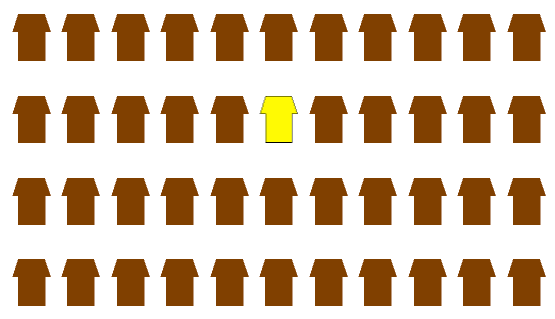
Notes
The yellow house represents a dwelling which had a HFSV.
Non-Domestic Fire Safety
In the data provided on non-domestic fire safety audits, it is important to note that there is variability within each premises category due to the size and nature of premises, number of employees and/or occupants, use of building and level of fire risk. There is also variability between FRSs. Each FRS decides which premises to audit each year; these decisions are made on a risk basis using various 'risk to life' assessment methods and the FRSs' knowledge and experience of the premises within their own geographical area. FRSs' fire safety audits are normally targeted at higher risk premises. This publication contains data from the third year of this collection. Due to the variability of FRSs policies, comparisons against the individual FRS's return from last two year are more useful than comparing across the eight FRSs for this year.
This year, the Houses in Multiple Occupation (HMO) category has been removed. This is due to variations in the definition and counting methodology used (see section 3.3). The information has still been supplied within this publication for reference purposes but it is not official statistics (Table 18).
All fire safety audits reported in this publication reached a 'compliant'3 outcome and were closed in 2011-12. Any audits that were still open at the end of the financial year 2011-12 will roll into 2012-13, the hours will be included in the year the audit was closed, when the FRS is satisfied that the premises has achieved the relevant level of compliance.
4.9 Premises (Table 13, 13a and 13b)
There were 143,815 non-domestic premises known to FRSs in Scotland for 2011-12. This has increased from 143,4564 in 2010-11.
The FRSs audit these premises on the basis of a structured programme depending on their own non-domestic fire safety policy. Five per cent of known non-domestic premises for Scotland were reported as having a completed compliant fire safety audit in 2011-12.
In Scotland, 55 % of care homes (1,286) were audited in 2011-12, whereas only 2 % of offices (483) were audited. (Chart 7)
Chart 7 - Percentage of known non-domestic premises audited in Scotland,
2011-12
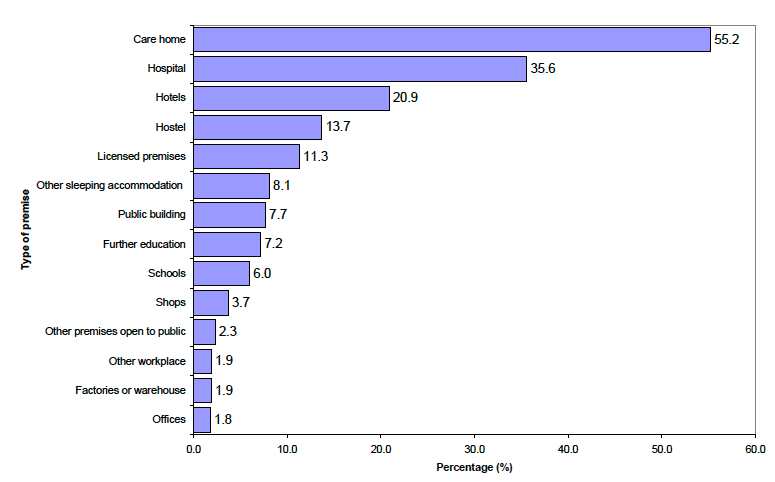
4.10 Fire Safety Audits, Enforcement and Prohibition Notices (Table 14, 14a, 15a, 15b, 15c and 15d)
In this publication, all hours are reported in decimals.
The number of hours completed on audits has increased from 40,884 in 2010-11 to 49,969 in 2011-12. The number of hours completed on enforcement and prohibition notices has decreased from 547 in 2011-12 to 412 in 2010-11.
For this publication a Type A audit is one where a premises has achieved compliant status after the initial fire safety audit is completed. Type B audits are those where the premises have not achieved the compliant status after the initial fire safety audit and further work is required by the FRS to assist the person responsible for the premises to make the premises compliant. A FRS may feel that a more formal action is required after a non-compliant audit and may issue a notice.
Lothian and Borders FRS have implemented a new fire safety legislation policy this year, which has meant that fire audits have been reclassified within their recording system. Though the total number of audits over this year and last year are approximately the same - the ratio of type A audits to type B audits has altered. The use of type A and B audits is a statistical classification for this return. All audits reported in this publication are complete and compliant within the financial year. The classifications of Type A and Type B help to identify the complexity of the audit.
In 2010-11, the ratio of the number of Type A to Type B audits in Lothian and Borders was 1 : 2.5 , this year it is 6 : 1 . The change in policy has therefore contributed to the overall increase in the proportion of Type A audits at the national level for this year.
In 2011-12, there were 7,555 fire safety audits completed; of these, 90 % were Type A and 10 % Type B. Shops were the premises with the highest percentage of Type A audits (97 %) and the lowest was 'other workplaces' at 82 % (Chart 8).
Chart 8 - Percentage of Type A and Type B audits completed in 2011-12 by type of premises - Scotland
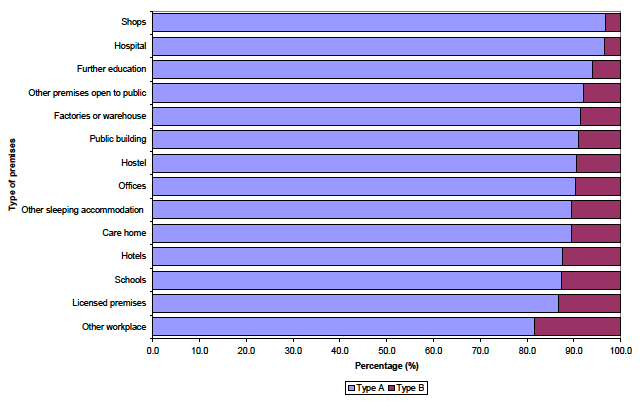
In 2011-12, the average time spent on Type A audits over all the types of premises audited was 6.2 hours, whereas a Type B audit took on average 10.9 hours. The premises with the highest average times for Type A audits were 'other premises open to the public' at 7.7 hours, whereas the lowest was for 'other workplaces' at 4.2 hours.
The highest average times for Type B audits were for care homes at 23.3 hours, whereas the lowest average time was 'other workplaces' at 2.4 hours.
There were 40 enforcement notices issued, with the largest number (13) being issued against hotels. The total number of hours spent on creating an enforcement notice across Scotland was 267.25 hours with an average of 6.7 hours per premises.
There were 26 prohibition notices issued, with the largest number (6) being issued against shops. The total number of hours spent on creating a prohibition notice was 144.25 hours with an average of 5.5 hours per premises.
There were no court appeals brought against enforcement notices. There was 1 appeal against a prohibition notice but this was resolved between the parties before the final appeal hearing was scheduled
4.11 Alteration Notices and Prosecutions (Table 16)
During 2011-12, 3 alterations notices were issued by Scotland's FRSs. At the end of 2011-12, there were 9 alterations notices in force. There were notices on the following type of properties: 1 on care homes, 3 on hotels, 2 on schools, 2 on shops and 1 on offices.
In 2011-12, there were no non-domestic fire safety prosecutions in Scotland.
4.12 Risk rating on Non-Domestic Premises (Tables 17, 17a and 17b)
The information in this publication uses the FSEC software methodology which provides scientifically-derived, consistent risk levels. This software has been used to produce statistics on the risk level of the premises where fire safety audits have been carried out. Different occupancy types will primarily lie in different risk levels due to the underlying calculations. Table B below shows the risk levels that the premises may achieve5 , for example, hospitals tend to range from 'well above average' to 'average' risk, it would be very unusual for a hospital to achieve 'below' or 'well below average' risk i.e. in Table B hospital tends not to occur within the shaded out areas. Offices on the other hand tend to range from 'average' to 'well below average' risk. (In Table B, the 2 highest categories have been shaded out to highlight this).
Table B: Template of risk for non-domestic premises types
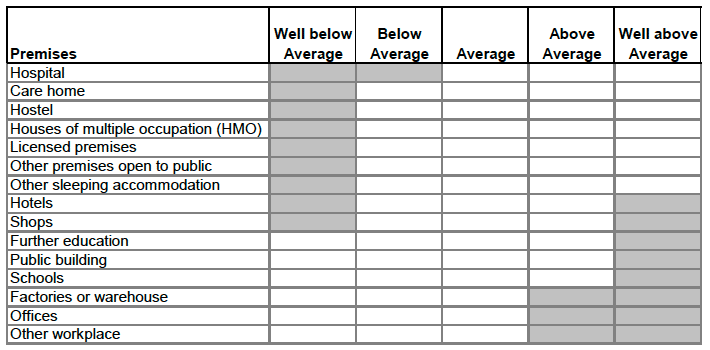
In 2011-12, of the 7,555 non-domestic premises audited in Scotland the largest percentage, 48 %, were of 'average' risk, 23 % were 'above average' and 1 % were 'well above average'.
The chart below show the percentage of risk within each type of premises audited
Chart 9 - Percentage of risk within premises type of audited premises in 2011-12 - Scotland
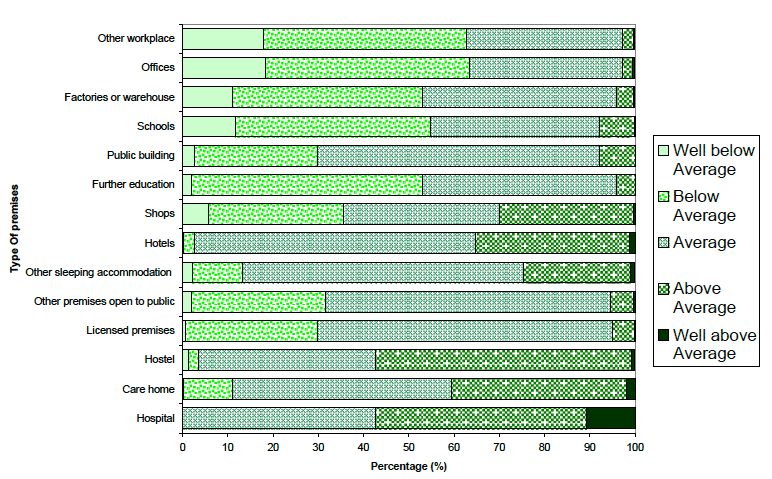
Looking at the percentages of audits within each premises type:
More than 10% of the audits carried out in schools, factories or warehouse, offices and other workplaces were in the 'well below average' risk category. At the other end of the scale, more than 1% of the audits in hospitals, care homes and hotels were classified as 'well above average' risk (Chart 9).
More than 29 % of audits in hospitals, care homes, hostels, hotels and shops were in the 'above average' risk category'.
More than 40 % of further education, schools, factories or warehouses, offices and other workplaces fell into the 'below average' risk category.
In Scotland, 177 premises that were audited had risk levels that fell outside of their expected risk profile. Of these 56 were recorded as 'above average' or 'well above average' risk.
The premises types which had over 30 % of audits within the 'above average ' or 'well above average' were hospitals, care homes, hostels, hotels and shops.
When the data is analysed within the risk categories
Of the 7,555 premises audited, 340 fell within the 'well below average' risk category. The highest proportion of these was shops, followed by offices (27 % and 26 % respectively). Shops also formed the highest proportion of 'below average' category (28 %).
Almost half the premises audited fell in the 'average' risk category (3,662 premises). Hotels, licensed premises and care homes accounted for over 50% of the audit premises with this category (18 %, 18 % and 17 % respectively).
Of the audits carried out in the 'above average' risk category, over 50% fell into two premises types: care homes and shops (29 % and 28 % respectively).
In the 'well above average' risk category, care homes formed the largest proportion at 33 %, followed by hospitals at 26 %.
(Tables 17, 17a and 17b provide national information - individual FRS information can be found in the excel tables supplied alongside this publication).
4.13 House in multiple occupation data (HMO) (Table 18)
Please note, this is not official statistics, please refer to section 3.3 for explanation.
In 2011-12, there were 2,700 safety audits on HMOs, either licensed dwelling or building. This took 9,331.25 hours. There were 9 enforcement notices issued and 2 prohibition notices that took 42.75 hours in total. At the end of 2011-12, there were 2 alterations notices on HMOs in force.
Of the HMOs audited one third were 'above average' or 'well above average' risk.
Contact
Email: Lindsay Bennison
There is a problem
Thanks for your feedback